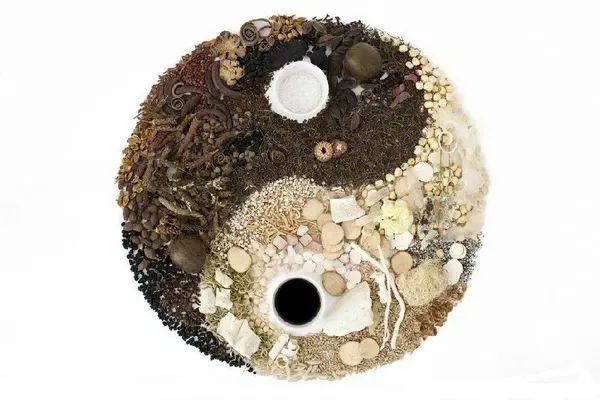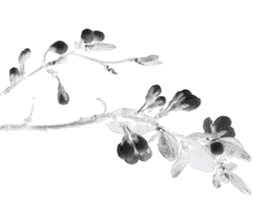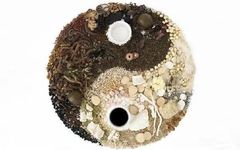
Click
Follow the blue text above
Follow us~


Meaning
Blood activating and stasis resolving herbs are primarily used to invigorate blood circulation and resolve blood stasis, commonly used in the treatment of blood stasis syndrome. What is blood stasis? In both modern medicine and TCM, blood is understood as the red liquid flowing within blood vessels, but TCM approaches it from a macro perspective without delving into the microscopic details. When the function of blood circulation is disrupted, it leads to blood stasis syndrome. To explain blood stasis, first, what does “stasis” mean?
In early TCM literature, blood stasis was referred to as “yu” (淤), which is a term borrowed from natural phenomena; it describes a situation where a river or ditch is blocked by solid objects, leading to accumulation or obstruction, similar to how a small river can be blocked by silt.
The earliest explanation of “yu” can be found in the “Shuo Wen Jie Zi” (说文解字), which states that it means “accumulated blood.” When blood accumulates in the blood vessels and cannot circulate normally, it is termed “stasis” or “blood stasis.”
Later, it was discovered that blood stasis can also occur outside the blood vessels, leading to the addition of the concept of “extravasated blood,” which refers to blood that has escaped from the vessels and accumulated between the organs and tissues, also known as blood stasis.
In TCM literature, blood stasis is explained as: 1. Accumulated blood, 2. Extravasated blood. Accumulation can occur both inside and outside the blood vessels. There are multiple causes of blood stasis: first, issues with the blood itself, such as insufficient energy to propel blood circulation, for example, qi deficiency or qi stagnation can lead to blood stasis. Additionally, if the blood becomes thickened, as Wang Qingren stated, “it congeals into clots,” and the “Huang Di Nei Jing” mentions, “it congeals in the cold,” indicating abnormalities in the blood itself; second, vascular issues, as mentioned in the “Huang Di Nei Jing,” where “blood vessels are constricted,” indicating that vascular spasms or dysfunction can also cause blood stasis. Thus, blood stasis can arise from both blood-related and vascular-related causes, accumulating either within or outside the blood vessels.
Blood activation and stasis resolution target the blood vessels, restoring their normal function to ensure smooth blood flow, referred to as unblocking the blood vessels.
Promoting blood circulation primarily focuses on restoring the normal flow of blood.
Dissolving blood stasis refers to promoting blood circulation to resolve accumulated blood, which may refer to blood clots within the vessels or extravasated blood outside the vessels, thereby treating blood stasis syndrome.
Unblocking the blood vessels, promoting blood circulation, and dissolving stasis are further simplified explanations of blood activation and stasis resolution.
Effects and Indications
The primary effect is to invigorate blood and resolve stasis, with milder actions often described in literature using the term “harmonize”; stronger actions, similar to qi-regulating herbs, can be quite potent and may easily deplete the vital energy, referred to as breaking blood.
Resolving stasis is commonly referred to as dispelling stasis; it can be termed dissolving stasis or moving stasis; stronger actions can also be termed expelling stasis.
Therefore, within blood activating and stasis resolving herbs, regardless of whether it is invigorating blood or resolving stasis, the variations in verbs are quite numerous, and one can use their preferred terminology without distinction. Only expelling stasis and breaking blood are reserved for a specific subset of potent herbs.
Blood stasis syndrome is mentioned relatively less in ancient literature, where it was referred to as old blood, dead blood, dry blood, stagnant blood, and bad blood, all of which essentially mean blood stasis.
Clinically, blood stasis syndrome can manifest in various conditions across multiple disciplines, including internal medicine, gynecology, pediatrics, and trauma. Therefore, its clinical manifestations are quite complex, with four major and common clinical presentations.
First, blood stasis obstruction leads to blocked blood vessels, resulting in pain; thus, blood stasis syndrome generally presents with varying degrees of pain, which is often fixed and does not move, unlike the wandering pain of qi stagnation, characterized by stabbing or dull pain, differing from the distending pain of qi stagnation. Pain is the most common symptom in diagnosing blood stasis syndrome.
Additionally, numbness can occur due to blood stasis obstruction, where the skin does not receive adequate nourishment.
Second, the presence of masses within the body; according to TCM theory, formless qi cannot form masses, and any mass is likely to dissipate easily. Any hard, fixed, and long-lasting mass within the body indicates the presence of tangible blood or phlegm, thus solid masses are generally caused by blood stasis or phlegm accumulation, or a combination of both.
Third, bleeding; blood vessel obstruction can easily lead to vessel rupture, resulting in stasis-related bleeding. Additionally, various parts of the body can exhibit purpura or petechiae, which are essentially extravasated blood forming spot-like or patch-like accumulations under the skin. Furthermore, the tongue is often purplish.
Of course, different disciplines may exhibit various manifestations of blood stasis syndrome; for instance, in gynecological conditions, blood stasis may cause pain and purple tongue, potentially affecting menstruation; if blood stasis obstructs the heart orifices, it can lead to restlessness, making it quite complex.
Different blood activating and stasis resolving herbs yield varying therapeutic effects; some may focus on pain relief, others on regulating menstruation, treating trauma, or resolving masses.
Therefore, blood activating and stasis resolving herbs can be categorized into blood-activating pain-relieving herbs, blood-activating menstrual-regulating herbs, blood-activating trauma-healing herbs, and blood-activating mass-resolving herbs.

Characteristics
The properties of blood activating and stasis resolving herbs are not regular. Blood congeals in the presence of cold; thus, cold pathogens causing stagnation and blood vessel obstruction are significant causes of blood stasis. However, blood stasis can also be caused by heat pathogens; ancient TCM literature, especially from the “Huang Di Nei Jing,” primarily emphasized cold-induced blood stasis. As clinical practice evolved, it was discovered that some blood stasis syndromes are not solely caused by cold pathogens; thus, Wang Qingren in the “Yi Lin Gai Cuo” proposed a well-known viewpoint that human blood can congeal into clots, indicating that heat pathogens have entered the blood. For example, in warm diseases, heat entering the blood can often lead to stasis, making blood activating and stasis resolving herbs crucial in treating warm diseases. This type of blood stasis is not due to cold congealing but rather due to heat pathogens consuming the yin fluids in the blood, resulting in thicker, more viscous blood, making circulation difficult, thus leading to blood stasis. It should be understood that it does not completely solidify but rather becomes more viscous and less fluid. Since blood stasis can arise from both cold and heat, some blood activating and stasis resolving herbs can warm and unblock the blood vessels to dispel cold pathogens, while others can clear heat pathogens from the blood vessels; hence, some are warming, and some are cooling, leading to irregular properties. However, most are warming; we only need to remember a few that are cooling, such as Dan Shen (Salvia miltiorrhiza), Yu Jin (Curcuma longa), and Yi Mu Cao (Leonurus japonicus).
However, other types of herbs with blood activating and stasis resolving effects are generally cooling.
For instance, in the category of heat-clearing and detoxifying herbs, Da Xue Teng (Sargentodoxa cuneata) and Bai Jiang Cao (Patrinia scabiosaefolia) are effective in treating intestinal abscesses and are inherently cooling. Da Huang (Rheum palmatum), a bitter cold purgative, is also a blood activating and stasis resolving herb. Additionally, in the category of heat-clearing and blood-cooling herbs, Mu Dan Pi (Paeonia suffruticosa), Chi Shao (Paeonia lactiflora), and Zi Cao (Lithospermum erythrorhizon) can cool the blood while also invigorating blood and dispelling stasis. Hu Zhang (Fallopia multiflora), which promotes diuresis and clears jaundice, is also a blood activating and stasis resolving herb and is cooling. Generally, blood activating and stasis resolving herbs should have a pungent flavor. “Pungent can move and disperse.” Pungent indicates the characteristics of dispersing and moving; blood activation and stasis resolution are primarily about movement, which includes moving blood, thus invigorating blood. However, for blood activating and stasis resolving herbs, some have a pungent and aromatic flavor, such as Chuan Xiong (Ligusticum chuanxiong) and Yu Jin, which have historically been recognized for their pungent flavor. However, many blood activating and stasis resolving herbs do not possess an aromatic or pungent stimulating flavor; ancient practitioners noted that bitterness can drain, dry (among the five flavors, bitterness can drain, clear, and promote flow), and they indicated that draining also includes breaking and dispersing, suggesting that it has blood activating and stasis resolving effects. Therefore, many blood activating and stasis resolving herbs have a bitter flavor, and this bitterness relates to both their properties and characteristics. Additionally, some blood activating and stasis resolving herbs are animal-derived, particularly from insects, which are often used to treat masses; ancient practitioners attributed a salty flavor to these herbs, which relates to the true flavor of animal blood and flesh products. More importantly, ancient practitioners introduced the theory that “salty enters the blood.”
For instance, in the category of heat-clearing and blood-cooling herbs, the well-known rhinoceros horn, now represented by water buffalo horn or Xuan Shen (Scrophularia ningpoensis), is noted in some literature for having a salty flavor. Thus, warm disease scholars refer to the treatment of heat-clearing and blood-cooling not merely as clearing heat and cooling blood but as “treating with salty cold.”
As for the meridian affinities, the heart governs blood vessels, and the liver stores blood. Blood stasis arises partly due to the heart’s governing function being impaired, leading to blood vessel obstruction. Additionally, the liver’s blood-storing function may be excessive, as Li Dongyuan stated, “evil blood must return to the liver“; evil blood refers to blood stasis. Therefore, the meridian affinities are primarily the heart and liver, especially the liver, which ancient practitioners emphasized more. Furthermore, the action tendency of blood activating and stasis resolving herbs is to promote smooth flow and dissolve congealed blood, thus these herbs tend to have a slightly upward and floating action. From a narrow perspective on toxicity, a few herbs are toxic, such as Strychnos nux-vomica, peach kernel, leech, and earthworm, which require special attention.
Compatibility and Application
First, addressing cold and heat as the primary pathogenic factors, blood activating and stasis resolving herbs are equally applicable.
For cold-induced blood stasis, they can be combined with warming herbs, especially those that warm the meridians and dispel cold, such as Gui Zhi (Cinnamon twig) and Rou Gui (Cinnamon), which are effective in entering the blood and warming the blood vessels; they are not blood activating and stasis resolving herbs themselves but can enhance the effects of blood activating and stasis resolving herbs in treating cold-induced blood stasis. If heat pathogens have congealed into clots, leading to heat-induced blood stasis or a combination of blood stasis and heat, it is essential to combine with heat-clearing herbs, with the first choice being heat-clearing and blood-cooling herbs, as they act on the blood level. Second, based on deficiency of the righteous qi, blood stasis is often associated with deficiency of qi, blood, yin, and yang. Yang qi is the driving force for blood circulation; blood carries qi, and qi moves blood. Therefore, when yang qi is deficient, the driving force is insufficient, leading to blood stasis. When yang qi is deficient, it is necessary to warm and tonify yang qi. Blood itself belongs to yin; insufficient yin essence, including deficiency of yin blood, can also easily lead to blood stasis. This aligns with Zhang Jingyue’s concept of “deficiency stagnation”; blood deficiency means insufficient blood, which slows its flow; just like a waterway, when there is more water, the flow is faster, and when there is less water, the flow slows down, hence ancient practitioners referred to it as a type of deficiency stagnation. Blood also contains yin fluids; when yin fluids are scarce, blood becomes thicker and less fluid, leading to this deficiency stagnation. Therefore, blood stasis syndrome often involves yin blood deficiency, necessitating compatibility with herbs that tonify yin and blood, addressing the deficiency of righteous qi, which commonly involves qi, blood, yin, and yang. Additionally, compatibility can be based on specific major symptoms; in blood stasis syndrome, the most common and regular symptom is qi stagnation, as qi is the driving force of blood. When qi is not flowing smoothly, it cannot effectively propel blood circulation, leading to qi stagnation and blood stasis. Therefore, in general blood activating and stasis resolving formulas, a certain amount of qi-regulating herbs can be added to enhance the stasis-resolving effect.
Furthermore, compatibility can be based on different syndromes; for instance, if blood stasis appears in abscesses or swellings, it can be combined with heat-clearing and detoxifying herbs;
if it appears in rheumatic pain, where wind, cold, and dampness affect blood flow, it can be used alongside wind-dispelling and dampness-dispelling herbs;
if phlegm and blood stasis are intermingled, it can be combined with phlegm-resolving or phlegm-dissolving herbs;
if it is a gynecological condition with menstrual irregularities, it can be combined with other menstrual-regulating or tonifying herbs, such as Xiang Fu (Cyperus rotundus) and Dang Gui (Angelica sinensis);
if it is a mass or accumulation, it can be combined with herbs that soften and resolve masses;
if blood stasis obstructs the heart orifices, leading to restlessness, it can also be combined with calming and tranquilizing herbs.

Usage Precautions
First, select herbs based on the syndrome, meaning choosing the best blood activating and stasis resolving herbs for different blood stasis syndromes. For instance, for blood stasis syndrome primarily characterized by pain, select herbs that excel in invigorating blood and relieving pain; if it is primarily characterized by menstrual irregularities, select herbs that excel in invigorating blood and regulating menstruation; if it is due to trauma, select herbs that excel in treating trauma; if it is a mass or accumulation, select herbs that excel in resolving masses. Additionally, herbs can be selected based on the cold or heat nature of the blood stasis; for cold-induced blood stasis, select warming blood activating and stasis resolving herbs; for heat-induced blood stasis, select cooling herbs with heat-clearing and blood-cooling properties, such as Mu Dan Pi and Chi Shao. Second, contraindications based on symptoms: pregnant women and those with excessive menstruation should generally avoid or use blood activating and stasis resolving herbs with caution, especially the stronger breaking blood herbs, as they can easily harm the fetus or induce miscarriage, making them contraindicated for pregnant women. If there is bleeding without blood stasis, blood activating and stasis resolving herbs should be avoided, as they generally exacerbate bleeding, especially potent blood activating and stasis resolving herbs, such as leeches, which can affect coagulation function, leading to increased bleeding risk; thus, blood activating and stasis resolving herbs are not suitable for bleeding syndromes without blood stasis. Third, stop when the condition improves. This means that even when blood activating and stasis resolving herbs are indicated, they should not be overused, as in TCM’s eight therapeutic methods, blood activation and stasis resolution fall under the category of dispersing methods, which generally deplete the vital energy or qi and blood. Blood activating and stasis resolving herbs can also deplete the vital energy; excessive use can impact the vital energy, as blood activation and stasis resolution enhance functional activity, which requires a material basis to support it, and excessive consumption ultimately depletes the body’s vital energy, necessitating stopping when the condition improves.
This article is sourced from: “Lectures by Renowned TCM Experts – Zhang Tingmo’s Clinical Chinese Medicine Lecture Notes”, compiled by Zhang Tingmo, published by People’s Medical Publishing House; copyright belongs to the original author!



Long press the QR code to follow us
Learn TCM
Let’s work hard together!

